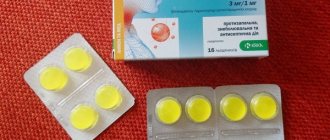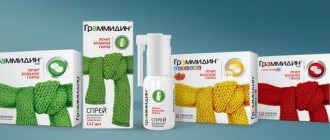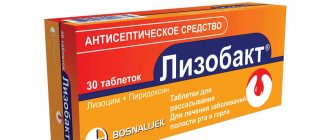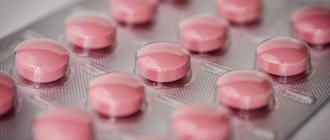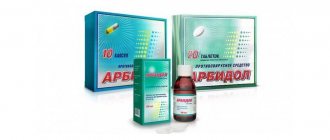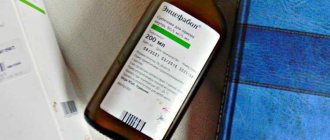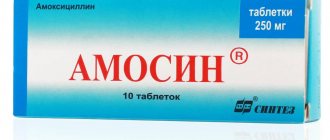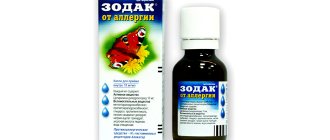Release form and composition
Sodium fluoride is available in the following dosage forms:
- Lozenges for children: round, flat-cylindrical, white (250 tablets in plastic bottles, 1 bottle in a cardboard box; 10 tablets in blisters, 3 blisters in a cardboard box);
- Orange lozenges for children: round, flat-cylindrical, chamfered, orange with darker inclusions, with an orange scent (10 tablets in blisters, 3 blisters in a cardboard box);
- Mint lozenges for children: round, flat-cylindrical, chamfered, white, with mint flavor (10 tablets in blisters, 3 blisters in a cardboard box).
1 tablet for children contains:
- Active substance: sodium fluoride – 2.2 mg;
- Auxiliary components: lactose, calcium stearate, potato starch.
1 tablet with orange flavor contains:
- Active substance: sodium fluoride – 1.1 mg;
- Auxiliary components: aspartame, mannitol, silicon dioxide, magnesium stearate, corn starch, Sunset Yellow Lake E 110 dye, Orange flavor.
1 tablet with mint flavor contains:
- Active substance: sodium fluoride – 2.2 mg;
- Auxiliary components: aspartame, mannitol, silicon dioxide, magnesium stearate, corn starch, Peppermint flavor.
Indications for use
Reviews of sodium fluoride indicate that the analyzed drug in the form of tablets and dragees (available in dosages of 20 mg and 40 mg) is prescribed in the following cases:
- With primary osteoporosis (its idiopathic form in young people, postmenopausal osteoporosis, as well as osteoporosis in older people, which most often entails serious consequences and complications);
- With secondary osteoporosis (occurs due to congenital fragility of bones, plasmacytoma, in some cases due to diffuse metastases of a tumor entering the bone tissue);
- If the patient has manifestations of otosclerosis and osteomalacia.
Lozenges in dosages of 1.1 mg and 2.2 mg are prescribed to prevent the development of caries in children (from 2 to 14 years old) living in areas where the fluoride content in water is less than 0.7 mg/l.
A solution of sodium fluoride for topical use is used to eliminate and prevent caries in children (from 7 to 14 years old) living in areas where the fluoride content in water is less than 1 mg/l.
Pharmacological properties
Pharmacodynamics
Fluorine ions affect the processes of mineralization of hard dental tissues during development, forming fluorapatites - the most resistant forms of apatites. Sodium fluoride enhances the inhibition of bone resorption and has a bactericidal and antirachitic effect (the latter by replacing hydroxyapatite with fluorapatite in bone trabeculae and stimulating osteoblasts). The drug has an anti-caries effect, reducing the cariogenic activity of dental plaque (especially in children and adolescents).
Pharmacokinetics
Sodium fluoride is absorbed quite quickly and completely, metabolized in the liver. Its maximum concentration in blood plasma is achieved in 30-60 minutes. The substance is excreted through the kidneys by 50% and is excreted in small quantities in sweat and feces. When taking any dose, approximately 50% of sodium fluoride entering the body accumulates in bone tissue and hard dental tissues, as well as in teeth and bones during the growth stage.
Contraindications
The use of sodium fluoride should be stopped immediately if the patient has hypersensitivity to this drug, hypothyroidism, duodenal or gastric ulcer, liver and kidney failure.
Reviews of sodium fluoride show that the drug is strictly forbidden to be prescribed during pregnancy and lactation, as well as for children under the age of six months, 3 years, 6 years and 16 years (this depends on the dosage of sodium fluoride, as well as the form of its release).
Sodium fluoride is not prescribed to people who live in areas where the amount of fluoride in water exceeds 0.8 mg/l.
Instructions for use of Sodium fluoride: method and dosage
Sodium fluoride tablets are taken orally, completely dissolved in the mouth, preferably after brushing your teeth before bed.
The following dosage regimen of Sodium fluoride for children is usually prescribed (daily dose):
- 2-5 years: 1 tablet (1.1 mg);
- 5-15 years: 1 tablet (2.2 mg) or 2 tablets (1.1 mg).
Until the age of 15, it is recommended to take sodium fluoride for teeth annually, for at least 250 days a year.
Sodium fluoride
Active substance:
Sodium fluoride
Pharmgroup:
Macro. and microelements
Average price in pharmacies
| Name | Manufacturer | average price |
| Sodium adenosine triphosphate 0.01/ml 1ml n10 amp solution i.v./ellar | BOPHARM | 239.00 |
| Sodium nucleinate 0.25 n50 tablet p/film/shell | Biosynthesis OJSC | 1369.00 |
| Sodium tetraborate 20% 30.0 bottle solution for external use prim/ind/pack/mff | MOSCOW PHARM. FACTORY | 28.00 |
| Sodium tetraborate 20% 30.0 bottle solution for places approx/Yaroslavskaya ff/ | Yaroslavl Pharmaceutical Factory, JSC | 26.00 |
| Sodium tetraborate 20% 30.0 bottle solution for places/external use/samaramedprom | IODINE TECHNOLOGIES AND MARKETING, LLC | 19.00 |
Analogs for the active substance:Sodium fluoratum Ossin |
Overdose
Symptoms of an overdose of Sodium fluoride are: increased fatigue, weakness, hypersalivation, lacrimation, decreased blood pressure, tachycardia, loss of appetite, nausea, vomiting, abdominal pain, diarrhea, respiratory failure, respiratory arrest, elevated body temperature, convulsions, tremor, myasthenia gravis. , miosis, visual disturbances, arthralgia, pain in the lower extremities.
As a treatment, fluid and calcium (milk, calcium lactate solution or calcium gluconate solution) are administered to quickly precipitate fluorides. Then the stomach is washed with 1% sodium chloride solution or acidified water, saline laxatives are prescribed and vitamins and electrolytes are administered intravenously (20 ml of 10–20% calcium gluconate solution). Symptomatic therapy and regular monitoring of calcium levels in the blood are also recommended. Hemodialysis gives good results in removing sodium fluoride from the body.
Side effects
- digestive system: dyspepsia, nausea, vomiting, diarrhea, anorexia, fluorosis (disruption of the process of formation and calcification of enamel, increased abrasion and fragility of teeth, the appearance of mottled spots, yellow and brown spots);
- allergic reactions: rhinitis, eosinophilia, skin rash;
- endocrine system: possible hypofunction of the thyroid gland (as a result of drug overdose);
- musculoskeletal system with long-term use in the maximum permitted doses: osteosclerosis, arthritis of the hip, knee and ankle joints, ossification of the attachment points of ligaments and tendons;
- nervous system: headache, increased fatigue, visual impairment.
special instructions
When using Sodium Fluoride for teeth, follow the instructions of the dentist and the doses recommended in the instructions. It is necessary to ensure that the child does not receive additional fluoride while taking other medications or nutritional supplements.
Sodium fluoride should not be prescribed to children under 10 years of age at a dose of more than 1 mg per day (due to the likelihood of developing dental fluorosis). The use of the drug in children under 6 years of age requires medical supervision.
To avoid the development of fluorosis, it is recommended to regularly conduct a dental examination of your teeth (at least 1-2 times a year).
For phenylketonuria, it is necessary to take into account that the flavored tablets contain aspartame, which is a source of phenylalanine.
Children with lactose intolerance should not take unflavored tablets.
Grindeks “Sodium fluoride” lozenges for children
Prescription drug Sodium fluoride 2.2 mg 250 pcs. lozenges.
Composition and release form
Tablets - 1 tablet:
active substance - sodium fluoride 2.2 mg;
excipients: lactose monohydrate, calcium stearate, potato starch.
Lozenges for children 2.2 mg.
10 tablets each in a blister pack made of polyvinyl chloride film and aluminum foil. 3 blister packs along with instructions for use in a cardboard pack.
250 tablets in a plastic bottle. 1 bottle along with instructions for use in a pack..
Pharmacokinetics
Absorption when taken orally is 93-97%. TCmax -4 hours. At any dose, 50% of the incoming fluorine accumulates in the hard tissues of the tooth and bone tissue. There is no accumulation in organs or soft tissues. Excreted by the kidneys (fluoride, which is not involved in the formation of bone tissue).
Pharmacodynamics
Sodium fluoride is an anti-caries preventive agent (especially in children and adolescents). Fluoride ions directly affect the processes of mineralization of hard dental tissues during their development. Additional introduction of fluorine ensures the formation of the most stable form of apatite - fluorapatite - in dental tissues. In addition, fluoride helps reduce the cariogenic activity of dental plaque. Inhibits the formation of lactic acid from carbohydrates.
Indications for use
Prevention of dental caries in children aged 2 to 14 years (if the concentration of fluoride in drinking water does not exceed 0.7 mg/l).
Dosage
Children aged 2 to 6 years - 1 tablet (1.1 mg) 1 time per day.
Children over 6 years old - 1 tablet (2.2 mg) or 2 tablets (1.1 mg) 1 time per day. It is recommended to take the drug before bed after brushing your teeth. The tablet is kept in the mouth until completely dissolved. The duration of treatment is at least 250 days a year, annually until the age of 15. It is not recommended to use medications containing calcium at the same time.
Precautionary measures
Do not exceed recommended doses and follow your dentist's instructions.
Make sure your child does not receive additional fluoride while taking other medications or dietary supplements.
Use in children under 6 years of age requires special monitoring.
To avoid the development of fluorosis, it is advisable to regularly conduct a dental examination of the child’s teeth at least 1-2 times a year.
Review: Grindeks "Sodium fluoride" lozenges for children - Rescue for children's teeth
28.10.2016
ADVANTAGES:
Strengthens teeth
FLAWS:
I haven't discovered it yet
In the summer of 2021, my son’s tooth broke off, under which pulpitis was discovered (even though the tooth was healthy on the outside) - it was repaired. A week later, another tooth chipped off again, and caries again! I asked my dentist how it could be that seemingly healthy teeth are affected on the inside. The answer: weak enamel. White spots on teeth are weak spots. Caries enters the tooth through a tiny hole between the teeth and grows. In the Volga region there is not enough fluoride in the water - that is why there is so much caries. In children under 15 (or something) years old, enamel is formed. Therefore, you need to take additional fluoride. Tablets before fluoridation (once every six months) have an advantage - fluoride nourishes the tooth not only from the outside (while you dissolve it), but also from the inside with the blood.
Prescribed to take Sodium Fluoride (this is what we have):
2.2 mg at night after brushing your teeth for 2 years, 250-270 days a year, with breaks on weekends. I decided to take a break for the summer months (I came across such a regimen) since fluoride is not compatible with calcium and vitamin D. I warned not to expect a quick result. Old caries will not disappear, but there should be less new ones.
We've been drinking for 2.5 months now. I noticed that the white spots on my teeth have disappeared, which means my teeth have become stronger!
I would like to note that additional intake of fluoride in regions where there is enough fluoride in the water can damage teeth. On the Internet you can find the composition of the water in your region if you search for “Russian water map”.
Be sure to consult your dentist before taking any medications! Read the instructions!
More details on Otzovik:
https://otzovik.com/review_3978032.html


